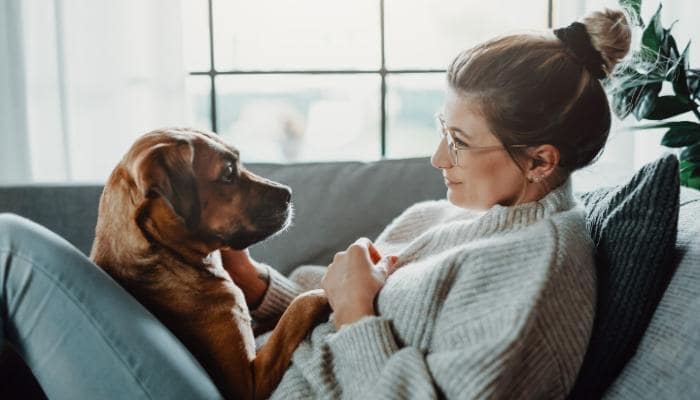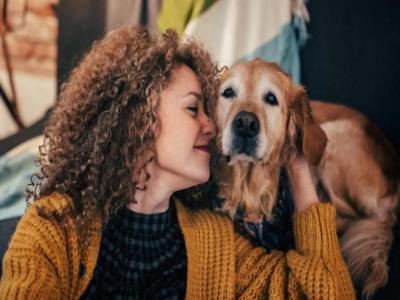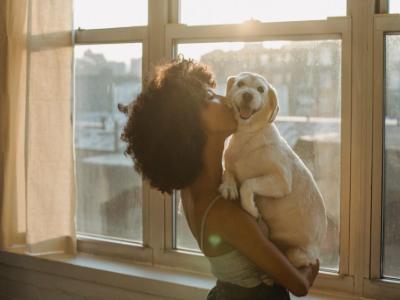If you are a dog person and still now able to give long-term commitment then fostering is for you, But “How to foster a dog?”
In this all-in-one guide, we are going to explore all the aspects of fostering a dog. So, join us in this fun exploration of fostering a dog!

How to Foster a Dog?
Dogs, like humans, thrive on love and security. Fostering a dog is a fulfilling experience. This step not only helps a dog but also the overall welfare of animals.
By giving temporary care and a loving home, you play a vital role in helping dogs transition to their next forever home[1]. For that let’s see some signs that you’re ready to foster a dog.
Dogs need your time and attention. Evaluate your daily routine to ensure you have enough time for feeding, walks, playtime, training and cuddles(of course). All dogs require exercise and mental stimulation, so make sure you are consistent with their routine after all a tired dog is a happy dog!
Let’s see what kind of dog you should choose:
- Puppies are full of energy and require more frequent potty breaks and play sessions. Adults, on the other hand, may have established habits and may need less constant supervision. Understanding these differences helps in taking care of the dogs.
- Fostering is flexible! You can decide as per your preferences based on your lifestyle. If you have a busy schedule, an adult dog may be a better fit. If you have the time and patience for training and socialization, fostering a puppy could be a rewarding experience.

Responsibilities of a Dog Foster Parent
Here are some daily care things you must take care of a foster dog:
“Choose the right food type and amount based on age, size, and health. Ask the rescue group or vet what they recommend for that dog. Feed meals at a set time every day to help digestion and feel secure”, says the experts at WebMD.
Brush regularly to keep their fur and skin healthy and hygienic. Trim nails when needed to prevent any pain. Physical and mental exercise keeps dogs happy. Walks, games, training – choose activities to their energy level.
Regular morning and evening walks are key for their health and happiness. A tired dog is a happy dog so, set a routine!
Make time for interactive play and games based on what the dog enjoys most. Use praise and treats to teach basic commands. This helps in obedience and communication.
Veterinary Care
Ensure the dog attends regular veterinary check-ups. Address any health concerns quickly and follow the recommended vaccination schedule. Administer preventive medications for fleas, ticks, and worms as advised by the vet.
Be vigilant about changes in the dog’s behaviour, appetite, or energy levels. Quickly seek the vet’s attention if any concerning signs arise.

The Cost of Fostering
Let’s see what are the essentials and how much they cost:
Dog Food and Treats
Ask the rescue group what food is best for the foster dog based on their health and nutritional needs. If changing foods, mix in the new food over a week or so.
Going slow helps avoid stomach upset. Pay attention to any food allergies or intolerances the dog may have. The rescue group likely has this information.
“Use small treats to reward good behaviour and reinforce training“, says Debra Horwitz from VCA Hospitals.
Choose treat sizes and flavours suitable for the dog’s size and preferences. Ask about any ingredient restrictions for their treats. You can even make simple homemade treats if you know what ingredients are safe for them to eat! Things like tiny pieces of dog-friendly fruits or vegetables.
Checking with the rescue group ensures you give fosters foods and treats that align with special dietary needs. This keeps them happy, healthy and comfortable while in your care!
Leashes, Collars, Etc
Choose a collar that fits snugly but not too tight. The leash should be (just) right for the dog’s size and strength. Ensure the collar includes an identification tag with your contact information and, if applicable, information provided by the rescue organization.
Consider using a harness, especially for dogs prone to pulling. This distributes pressure more evenly and reduces strain on the dog’s neck. Harnesses can also be useful for training, providing better control during walks and preventing escapes.

Discuss with the rescue organization the option of microchipping the foster dog for permanent identification. This enhances the chances of reuniting lost dogs with their owners. Ensure that the microchip information is regularly updated with your current contact details.
Additional Supplies
Get durable food and water bowls that won’t tip over or stain. Consider raised bowls for big dogs to help them eat comfortably.
Provide a soft, washable bed so they have space to sleep and rest. Buy fun but safe toys and chews to keep them happy and prevent boredom chewing or destruction when alone. Rotate toys to make it more interesting!
Have the right grooming supplies for their coat type – brushes, combs, a nail clipper etc. Regular grooming keeps them healthy.
Emergency Costs The rescue group probably covers basic vet fees but extra funds help in case of surprises. Be ready to pay for unexpected medical issues if they come up.
Always tell the rescue group right away if the dog seems sick or hurt. Working together means giving fosters the best care possible. Open communication about all health concerns is key!
The goal is setting up fosters for success by having the basic supplies they need to be comfortable, healthy and happy! This helps them thrive while temporarily in your home.

Preparing Your Home and Heart to Foster!
Let’s see various ways you can prepare your home for a foster dog:
- Puppy-proof your home. Puppies explore with their mouths. Remove or lock away anything dangerous they could chew or choke on. Use trash cans with tight lids.
- Secure wobbly furniture and prevent access to unsafe areas with baby gates. Crate train to give them a safe, cosy place to relax. Choose a crate big enough for them to lay down and turn around comfortably. Put soft bedding inside.
- Set out tip-proof food and water bowls within easy access. Provide interactive toys to keep them stimulated and happy when alone. Rotate toys to keep it interesting!
- Establish a schedule with regular mealtimes, potty breaks, walks, and play sessions. This predictability is comforting.
- Spend good quality time with them. Gently pet them and offer affection as they learn to trust you. Gradually allow access to more rooms once they are comfortable.
- Ensure they always have a clear path to exit safely in an emergency. Keep emergency supplies handy, like a first aid kit. Save key contacts for their rescue organization.
The goal is to set them up for success by removing hazards and establishing a predictable, enriching routine filled with compassion and care. This helps shy or fearful dogs relax and shine!
Fostering Dogs with Emotional or Behavioral Issues
Fostering dogs with emotional and behavioural issues takes a little more patience, let’s see how can you do that:
Signs of Trauma or Anxiety
Pay close attention to the dog’s body language, which often provides clues about their emotional state. Look for signs of fear, anxiety, or stress, such as trembling, excessive panting, or cowering.
Gather information from the rescue organization about the dog’s past experiences. Understanding their background can help anticipate potential triggers.
Some dogs may withdraw and avoid interaction when feeling anxious or stressed. Others may display aggression or fear-based reactions as a defence mechanism. Dogs may vocalize excessively or engage in destructive behaviours when feeling anxious.

Continue to monitor the dog’s behaviour regularly, especially during the initial adjustment period. Behavioural patterns may evolve as the dog becomes more comfortable in your home.
Positive Reinforcement Techniques
Approach foster dogs slowly and gently. No sudden movements or loud noises. These can scare them. Give treats and use a soft, kind voice to help them feel safe with you.
Create a consistent routine for them – regular mealtimes, walks, and playtime. This schedule makes anxious dogs feel more secure. Give them a quiet space they can retreat to if they feel overwhelmed.
Introduce new things gradually. Let them warm up to people, places and other pets slowly so they gain confidence. Reward calm, friendly behaviour with treats and praise. Don’t push them too fast.
Use positive training methods[2]. Treats and rewards are best, not punishment. Teach simple commands to stimulate their mind and make them more secure through structure. Play games that boost their problem-solving too.
The goal is to be patient – let foster dogs learn at their own pace that they are safe and that life can be good again. Go slow with lots of love and their true happy personality will emerge!
Fostering Rewards
Fostering a dog helps them find a good home. Shelters often do not have enough space or money to care for all dogs. When you foster a dog, you free up space for other dogs at the shelter.
Taking a foster dog into your home gives them love and attention. This helps them become happier and friendlier. It helps dogs that were lost, hurt, or scared in the past.
Fostering also shows people why adopting dogs is important. When you share your fostering experience, more people might want to adopt. Shelters can use the space to take in more dogs who need help finding a family. Adopting also means fewer unwanted puppies being born.
Fostering saves the lives of many dogs and helps them find loving homes. It frees up shelter space to rescue more dogs. It’s a kind way to help dogs in need.
Facilitating Successful Adoptions
Living with a foster dog lets you learn all about them. You get to know what they like, what they don’t like, and their personality. This helps match them to the perfect forever home.
You can tell potential new owners how the dog behaves at home, their training, and if they get along with other pets. This information helps new owners make a good choice.
Dogs often show their true personality while fostering in a home. This makes it easier for new families to see if the dog is a good fit. The dog can relax and be themselves rather than be stressed inside a shelter.
Fostering provides a routine for the dog. This makes changing homes smoother when they get adopted. You can also work on any behaviour issues, so they have good manners for their new home.
It is very rewarding to see a scared dog transform into a happy, confident pet while in your care. Saying goodbye can be sad. But you get fulfilment since you helped find them a loving forever home.

How to Get Started?
Let’s see how can you start this process. Firstly, find animal shelters near you that need foster homes for dogs. You can search online or call local shelters to ask.
Tell the shelter you want to become a foster parent for dogs. Ask questions like:
- How much time will fostering take?
- What types of dogs need fostering? For example, puppies, senior dogs, or dogs that need medical care.
- Does the shelter give any training or advice to help new fosters?
- What supplies does the shelter provide for fosters? Like food, beds, or toys.
- Who can you contact if you have questions while fostering?
Getting this basic information will help you decide if fostering is right for you.
Step 1: Understanding their Application Process
Becoming a dog foster parent starts by finding a local animal shelter or rescue group with a fostering program. Contact them to express interest and ask questions about what’s involved.
Keep an open line of communication so the shelter staff can match you with a good fit for your first foster dog. The application process ensures they find temporary homes for a positive fostering experience.
➡️Gaining Insights into the Fostering Experience
Before bringing home your first foster dog, make sure to attend any training workshops or information sessions offered by the animal welfare organizations. An informed foster parent is important in dogs and preparing them for adoption into loving forever homes.
Connect with experienced foster parents during workshops or through online platforms. Building a network allows you to seek advice, share experiences, and learn from those who have successfully fostered dogs.
Step 2: Your Preferences
Specify the types of dogs you feel comfortable fostering, considering factors like size, age, and energy level.
Express any limitations or boundaries you may have, such as rules on the number of dogs or specific behavioural challenges you are not prepared to handle.
➡️Home Visit and Approval
Expect a home visit from a representative of the rescue organization. They will check the safety and suitability of your living environment for a foster dog.
Ensure that your home is dog-proofed and that safety measures, such as secure fencing and safe living spaces, are in place.
Step 3: Addressing Concerns
Be ready to talk to them and answer any questions during the home check. If they are worried about something, work with them to fix it. For example- having a fenced yard, moving harmful chemicals out of reach, or buying gates to keep certain rooms or areas closed off.
The key is showing you want what is best for the foster dogs and are willing to make changes for their safety and happiness.

Ask questions too if there’s something you don’t understand. Clear communication is important so everyone is on the same page. Working together leads to good solutions so more homeless pets have a supportive place to stay until adoption.
Step 4: Welcoming Your First Foster Dog
Prepare yourself emotionally for the temporary nature of fostering and the potential challenges that may arise.
Understand that each dog will have unique needs and may require time to adjust. Create a consistent daily routine for feeding, walks, playtime, and training. Predictability helps the foster dog adjust to their new environment.
FAQs
❔Do Dogs Get Sad When They Change Owners?
These are normal as the dog is not used to its new environment. Sometimes, it may cry or whine. Also, feelings of reluctance and shyness are not uncommon. A dog with a neglectful previous owner might also find it hard to adjust to you if you give it too much attention.
❔How to Foster a Dog?
If you’re a first-time dog foster parent, talk to experts and read all you can about caring and training for dogs. This includes buying essentials, toilet training, teaching commands and more. Speak to a shelter, NGO or even a trainer to understand how to foster a dog.
❔How Long Will a Dog Remember a Person?
Conclusive evidence of how many years a dog can remember a person or event is lacking, likely because of the difficulty of conducting such a lengthy study. That said, most researchers believe dogs can remember important people and significant events in their lives for years, perhaps until death.
❔How Do Dogs Choose Their Favourite Person?
As social animals, dogs choose the person or people who give them plenty of love, attention, and positive experiences. Let your dog be a dog and enjoy hanging out with and being in that person’s presence, whether it’s you or someone else. But don’t give up on being one of the favourites!
❔How to Foster a Dog for the First Time?
If you’re a first-time dog foster parent, talk to experts and read all you can about caring and training for dogs. This includes buying essentials, toilet training, teaching commands and more. Speak to a shelter, NGO or even a trainer to understand how to foster a dog.
Conclusion
In conclusion “How to foster a dog?“, our guide will help you at every step of the process.
By opening your home to fostering a dog, you are not only helping the organizations with overcrowding but also to a dog before he finds his forever home.
So, be prepared for this wonderful experience and enjoy your time to the fullest, Happy fostering!
Reference:



